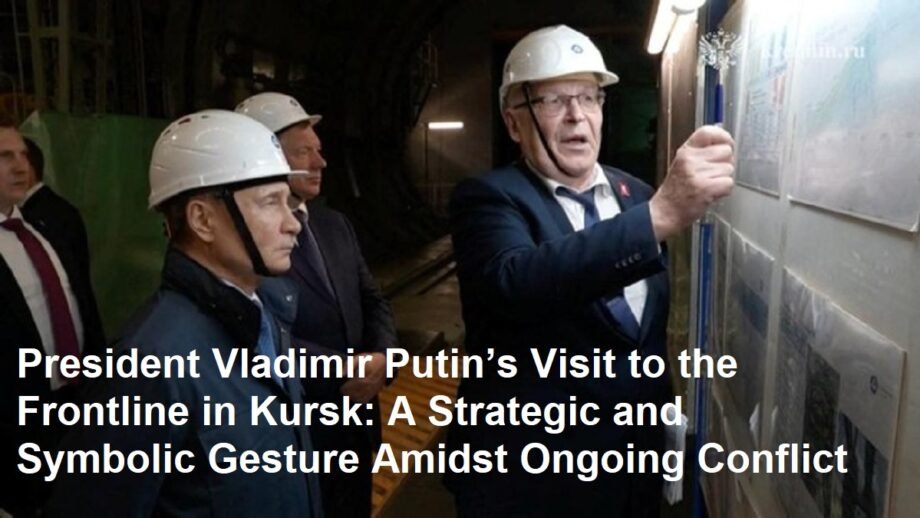Introduction
On May 20, 2025, Russian President Vladimir Putin made a highly significant and symbolic visit to the frontline in the Kursk region, a critical area near the Russia-Ukraine border. This visit comes amid the protracted and complex Russia-Ukraine conflict that has reshaped geopolitical dynamics in Eastern Europe and beyond. Putin’s presence at the frontline is not merely ceremonial; it carries deep strategic, military, and political implications that reflect Russia’s ongoing commitment to its military objectives and domestic stability. This article provides a comprehensive analysis of the visit, emphasizing its multifaceted significance within the broader context of the conflict and international relations.
Putin’s visit to Kursk serves as a powerful demonstration of leadership and resolve, reinforcing Russia’s stance in the face of international sanctions and diplomatic pressures. It also aims to boost troop morale, provide direct military oversight, and send a clear message to both domestic and international audiences about Russia’s unwavering position in the conflict. This article will explore these dimensions in detail, supported by authoritative sources and strategic analysis.
Strategic Importance of the Kursk Region
The Kursk region holds immense strategic value for Russia in the ongoing conflict with Ukraine. Located in western Russia, Kursk acts as a vital buffer zone adjacent to contested Ukrainian territories. Since the escalation of hostilities in 2022, this region has witnessed intense military activity due to its logistical significance and proximity to the frontline.
Control over Kursk is crucial for several reasons:
- Logistical Hub: Kursk serves as a key supply and reinforcement route for Russian forces operating near the Ukrainian border. Maintaining secure lines of communication and supply is essential for sustaining military operations.
- Territorial Buffer: The region acts as a defensive barrier protecting deeper Russian territory from potential Ukrainian advances or NATO influence.
- Symbolic Value: Kursk’s historical significance, notably from World War II battles, adds symbolic weight to its control, reinforcing nationalistic narratives within Russia.
Putin’s visit to this region underscores its importance in Russia’s military strategy and territorial ambitions. By personally inspecting the frontline, Putin signals Moscow’s determination to hold and possibly expand its influence in this critical zone, which remains a focal point of the broader conflict dynamics.
Military Significance of Putin’s Visit
From a military perspective, Putin’s frontline visit is a rare and calculated move that carries several key implications:
- Boosting Troop Morale: High-level visits to active combat zones are uncommon due to security risks, but they serve as powerful morale boosters for soldiers. Putin’s presence conveys solidarity and support, which is vital for troops engaged in a prolonged and challenging campaign.
- Direct Command and Control: The visit allows Putin to engage directly with commanders and frontline personnel, gaining firsthand insights into battlefield conditions. This can inform strategic decisions and operational adjustments, enhancing command responsiveness.
- Demonstration of Strength: The visit projects an image of Russian military resilience and readiness, countering narratives of weakness or retreat. It reinforces the message that Russia remains fully engaged and capable in the conflict.
Military analysts note that such visits often coincide with critical phases of a campaign, serving both practical and psychological functions. Putin’s inspection of defensive positions, logistics hubs, and troop deployments in Kursk highlights the ongoing importance of this region in Russia’s operational planning.
Political and Domestic Implications
Domestically, Putin’s visit carries significant political weight. Since the conflict’s onset, the Russian government has faced mounting pressures related to economic sanctions, public opinion, and the human costs of war. The visit serves several political purposes:
- Projecting Leadership: By appearing on the frontline, Putin reinforces his image as a decisive and hands-on leader, willing to share risks with his troops. This helps consolidate his political standing amid domestic challenges.
- National Unity and Patriotism: The visit is a symbolic act designed to galvanize patriotism and national unity. It fosters a collective spirit of endurance and resilience, crucial for maintaining public support during wartime hardships.
- Countering Dissent: Visible leadership in conflict zones can mitigate dissent and skepticism about the war effort, reinforcing narratives of strength and legitimacy.
The visit also aligns with state media strategies that emphasize Putin’s role as a protector of Russian interests and sovereignty. This messaging is critical in sustaining morale on the home front and managing the socio-political impacts of prolonged conflict.
International and Geopolitical Messaging
On the international stage, Putin’s Kursk visit sends a clear and calculated message:
- Defiance Against Sanctions: The visit signals Russia’s refusal to yield to Western sanctions and diplomatic isolation, asserting its strategic autonomy and resilience.
- Negotiation Leverage: By demonstrating resolve and control, Russia aims to strengthen its position in any ongoing or future diplomatic negotiations related to the conflict.
- Countering Western Narratives: The visit challenges narratives of Russian military decline or internal instability, projecting an image of strength and cohesion.
This geopolitical signaling is particularly relevant given the complex international responses to the Russia-Ukraine conflict, including NATO’s support for Ukraine and shifting alliances. Putin’s presence at the frontline underscores Russia’s commitment to its strategic goals despite external pressures.
Broader Context of the Russia-Ukraine Conflict
The Russia-Ukraine conflict, which escalated dramatically in 2022, remains one of the most significant geopolitical crises of the 21st century. It involves complex historical, ethnic, and political factors, with wide-ranging implications for regional security and global power dynamics.
Putin’s visit to Kursk must be understood within this broader context:
- Protracted Conflict: The war has evolved into a prolonged and multifaceted confrontation, with shifting frontlines and ongoing military engagements.
- International Involvement: Various international actors, including NATO, the European Union, and the United States, have played roles in supporting Ukraine or mediating the conflict.
- Humanitarian Impact: The conflict has caused significant human suffering, displacement, and economic disruption, affecting millions of people.
In this environment, high-profile visits like Putin’s serve multiple functions: reinforcing military objectives, shaping domestic and international perceptions, and influencing the trajectory of the conflict itself.
Conclusion
President Vladimir Putin’s visit to the frontline in Kursk on May 20, 2025, represents a strategic and symbolic gesture with profound military, political, and geopolitical implications. It highlights the critical importance of the Kursk region in Russia’s military strategy, serves to boost troop morale, and projects an image of resolute leadership amid ongoing challenges. Domestically, the visit reinforces national unity and political stability, while internationally, it signals Russia’s steadfastness in the face of sanctions and diplomatic pressures.
As the Russia-Ukraine conflict continues to evolve, such high-level engagements will remain key instruments in shaping the course of the war and the broader geopolitical landscape. Understanding the multifaceted significance of Putin’s Kursk visit provides valuable insights into Russia’s strategic calculus and the enduring complexities of this conflict.









